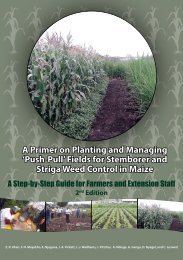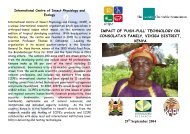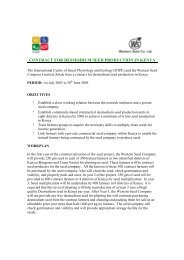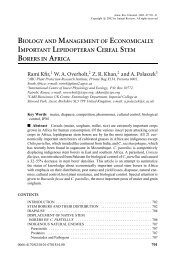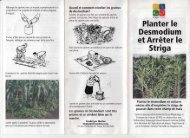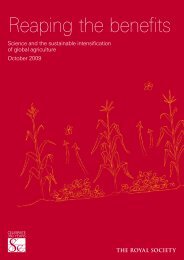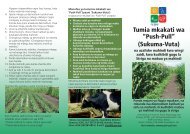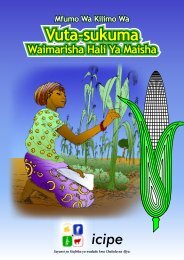a model for Africa's green revolution - Push-Pull
a model for Africa's green revolution - Push-Pull
a model for Africa's green revolution - Push-Pull
Create successful ePaper yourself
Turn your PDF publications into a flip-book with our unique Google optimized e-Paper software.
<strong>Push</strong> and pull: plants versus pests 7<br />
1. <strong>Push</strong> and pull: plants versus pests<br />
The Were family are subsistence farmers who eke<br />
out a living on the Kenyan side of Lake Victoria.<br />
It is not an easy life; their farm is small and rainfall<br />
is often unreliable. Yet the Weres are better<br />
off than many of their neighbours: fields of tall,<br />
strong maize plants promise ample food <strong>for</strong> the<br />
next six months; three crossbred dairy cows enjoy<br />
a plentiful supply of fodder brought to their stalls;<br />
the children drink milk every day; and sales of<br />
milk, maize and fodder grass bring in vital cash to<br />
spend on daily necessities and to invest in farm<br />
and household improvements.<br />
Only two years ago, the scene was dramatically<br />
different. Years of cereal cropping without inputs<br />
had reduced soil fertility and the maize plants<br />
were being attacked by insect pests and parasitic<br />
weeds. The family’s thin zebu cows produced little<br />
milk, and herding them along the roadside to find<br />
<strong>for</strong>age was a full-time job <strong>for</strong> the children. Meanwhile,<br />
Christine Were was constantly engaged<br />
in the backbreaking, seemingly fruitless task of<br />
weeding the fields. The granary was empty, the<br />
family frequently went hungry, and there was no<br />
Christine Were inspects her healthy push–pull maize crop.<br />
Christine Were shows icipe technician, Dickens Nyagol, her traditional maize<br />
plot. Only two years ago all her fields looked like this: the maize was devastated<br />
by dual enemies - the stemborer Chilo partellus and the parasitic weed<br />
Striga hermonthica.<br />
maize left over to sell. That meant no money to<br />
invest in fertilizer or other inputs to improve the<br />
situation. The family seemed trapped in a downward<br />
spiral of declining yields and deepening<br />
poverty and hunger.<br />
How were the family’s <strong>for</strong>tunes turned<br />
around in such a short time The answer lies in a<br />
novel approach to crop management that exploits<br />
the natural relationships between plants and insects.<br />
When scientists investigated the ecology of<br />
a widespread cereal pest, they discovered that introducing<br />
a carefully selected mix of <strong>for</strong>age plants<br />
into maize fields had a dramatic effect on cereal<br />
yields and total farm output. The so-called ‘push–<br />
pull’ technology that emerged from their research<br />
(see box on next page) makes use of natural plant<br />
chemicals that drive insect pests away from the<br />
crop and attract them to other host plants, which<br />
withstand attack better than maize. Along the way,<br />
the scientists discovered intriguing new properties<br />
in the <strong>for</strong>age legume, desmodium. Besides<br />
being nutritious <strong>for</strong> dairy cows, it repels insect<br />
pests of maize and substantially reduces damage<br />
from striga, a destructive parasitic weed. In short,



